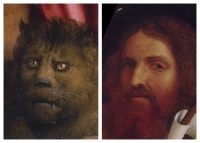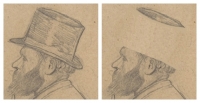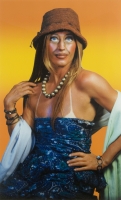09 Jan 2014 | 7 Comments
Keith Haring’s Secret Knowledge
EPPH has already shown how at least 7 major artists depicted themselves as lions (see below). There are more to come but many are by Old Masters and are quite subtle. Here’s an obvious example, an actual self-portrait, by an artist who was all
15 Dec 2013
Lotto’s Lion and The Mystical Marriage of St. Catherine
After the recent post about how Sir Edwin Landseer became a couple of dogs (seriously), I thought it would be a good idea to keep up the pace and show how Lorenzo Lotto became a lion. Near the lower edge of one of his greatest masterpieces, The
18 Nov 2013
Giacometti’s Visual Illusion Blows My Mind
Yesterday, after posting the entry on Giacometti’s Self-portrait with Brush (above), I saw something astonishing. It's a good reminder that even when you think you understand, there's still more to know. And it comes with perserverance and the
14 Oct 2013
The Error of Art History
Yesterday I wrote about how some errors make the world interesting and beautiful. This one does not.
Read the Journals of Ralph Waldo Emerson, who rarely saw great art, and you will learn about it on every page because the truths
18 Sep 2013
A Hair-raising Tool to Understand Art
It's interesting to learn something new about an artwork but even more exhilarating to learn the craft itself by acquiring the mental tools used to interpret what few can see. We all paint the world the way we think it or are told to think it by
14 Jul 2013
Resemblance in an Animated Face
Can two quite different faces each resemble the artist? The answer is yes, because the visual processes of the brain do not need to see similarity in all features. Your visual cortex is clever and can color in what you cannot see or have not see
12 Apr 2013 | 7 Comments
How a Scientist Solved the Puzzle of the Mona Lisa
The true identity of Leonardo's Mona Lisa has been a long-running mystery captivating generations of art lovers and scholars. Yet the most crucial piece of information about the Mona Lisa missing from standard textbooks is that the proportions o
10 Apr 2013 | 1 Comments
Leonardo’s Facial Mystery
The discovery that great portraits do not depict identifiable people, as long believed, is a real eye-opener. (See the book free online titled Every Painter Paints Himself.) Yet the significance of what you can now see in portraiture can only be
20 Mar 2013 | 2 Comments
How Degas drew a top hat…
Art is so pregnant that even in a "simple" sketch like Degas' Edouard Manet at the Races (c. 1865) there is always something more. I thought I had drained the drawing when I finished writing about it yesterday (see entry). And, then, this m
09 Mar 2013
Proust’s and Degas’ Disappearing Models
Literature and its methods are a useful yardstick by which to judge our knowledge and understanding of the visual arts. For instance, the known fact accepted by literary critics that many friends and acquaintances of Marcel Proust, the great Fre
25 Jan 2013 | 3 Comments
Picasso’s Unseen Portrait at the Metropolitan Museum
I was going to write about how the objects most frequently depicted by the Cubists in their café still-lifes – pipe, bottle, glass and guitar – were used not primarily as items characteristic of café-life as Rosalind Kr
23 Dec 2012
1, 2, 3. Please start here.
"The poets", a great literary critic once wrote, "do not read the same books as the academics or do not read them in the same way." She added, to explain how all great poetry is on the same path, that the gnosis of mind, or inner wisdom they sea
20 Dec 2012
Whose face is the Sphinx?
I've been trying to read while a Nova documentary, The Riddle of the Sphinx, played in the background. The narrator described how an Egyptian stone carver called Fahi had been commissioned to sculpt a small-scale version using local stone. "
01 Dec 2012
Pointing at the Edge
If you cruise the various interpretations on this site, you might have noticed a tendency to explain a figure with an arm or hand pointing to or touching the edge of the image as the artist himself painting a self-portrait. Michael Fried first n
17 Nov 2012
Mental images from Holbein, Ingres and Picasso
It is well-known that Picasso admired Ingres' portrait drawings like the one above on the left. Separately I have shown how Ingres, like other great masters, changed the facial features of his sitters to fuse them with his own. Not all portraits
16 Oct 2012
Picasso was Rembrandt
Under the theme 'Artist as Other Artist' I show how many painters and sculptors over the centuries have, in one way or another, adopted the persona of an earlier artist. The mask they then inhabit helps disguise their own role within the
06 Oct 2012 | 1 Comments
How Shakespeare Became a King
I demonstrated several years ago that many of the most iconic portraits of Europe's rulers, including those of many British kings and at least four of her queens, so closely resemble the artist's self-portrait that they are not portraits as we t
19 Jul 2012
Susan Sidlauskas and the Many Faces of Hortense Cézanne
In a relatively recent book on Paul Cézanne's portraits of his wife, Hortense, Susan Sidlauskas examines the nearly 30 images he made of her over a fourteen-year period in greater detail than has ever been done before. It is an import
11 Jul 2012
Bless you! It’s Art
Keep your eye open for a handkerchief or white cloth. They can be highly significant. My own experience suggests that those who are not painters themselves are relatively unaware that a cloth is almost as important to the craft of painting as a
23 Jun 2012
Cindy Sherman: Inside and Out
Cindy Sherman stands in an odd position in my pantheon of art. Her portraits, critics repeatedly tell us, are self-portraits but at the same time are not about her. That is my dilemma. The very characteristic that would make Sherman’s work
31 May 2012
Francis Bacon on Portraits and Crosses
I’ve just been reading a series of essays on Francis Bacon and have come across two quotes that I must pass on. A young doctoral student had some long conversations with Bacon in 1975 in which Bacon was saying that when he looks at a great pai
18 May 2012
Joseph Leo Koerner and the Artist as Christ
Occasionally I see an image that turns on a light and helps illuminate an artist's way of seeing quite concisely. Fittingly, an illumination is one of them. The best book ever written on self-portraiture is probably Joseph Leo Koerner’s The Mo
11 May 2012
Face-off. Keep an eye on the details.
I try not to write too much about portraiture because pointing out “face fusion” time and again can become a bit repetitive. Occasionally, though, it is worth reminding readers, especially new ones, that even portraits that do not re
08 May 2012
Is Painting Art?
This website, EPPH, is founded on a few principles that bear repeating, especially for new users. One of the most important concerns art’s definition. What is art? We believe that drawing and painting are crafts, not arts. Almost any motiv
25 Mar 2012
Quotation of the Week #7
Edward R. Murrow, the famous American radio and TV journalist, did not have great portraits in mind when he said:
“The obscure we see eventually.The completely obvious, it seems, takes longer.”
22 Mar 2012
Johan Zoffany
I just missed, by all accounts, a landmark exhibition at the Yale Center for British Art in New Haven, the first major exhibition devoted to Johan Zoffany (1733-1810). It just moved to the Royal Academy in London where it will stay until June 10
13 Mar 2012
Titian as Raphael
I've just added an entry on a little-known but very intriguing portrait by Titian, known simply as Titian's Portrait of a Gentleman. Painted around 1520, it is, I believe, Titian's tribute to the recently-deceased Raphael. Hanging in the Palazzo
29 Jan 2012
Leonardo on Creating Art as the Subject of Art
I often argue that the subject of a painting is its own making and have already demonstrated this online in several hundred entries, including examples by Leonardo.1 Evidence in written commentary by artists, though, is much rarer. Nevertheless
21 Dec 2011
The Renaissance Portrait from Donatello to Bellini #5
Continuing our series in honor of the Metropolitan Museum's current exhibition of Renaissance portraits we have Botticelli's portrait of Michele Marullo Tarcaniota on the left compared to Botticelli's earlier self-portrait on the rig
10 Dec 2011
Portraits: Icons of America
Portraits make popular art exhibitions because we all think we can “read” a face. It’s part of being human. Everyone is his or her own expert on other people’s faces. Besides, portraits help satisfy our natural inquisitiv
The EPPH Blog features issues and commentary.





























